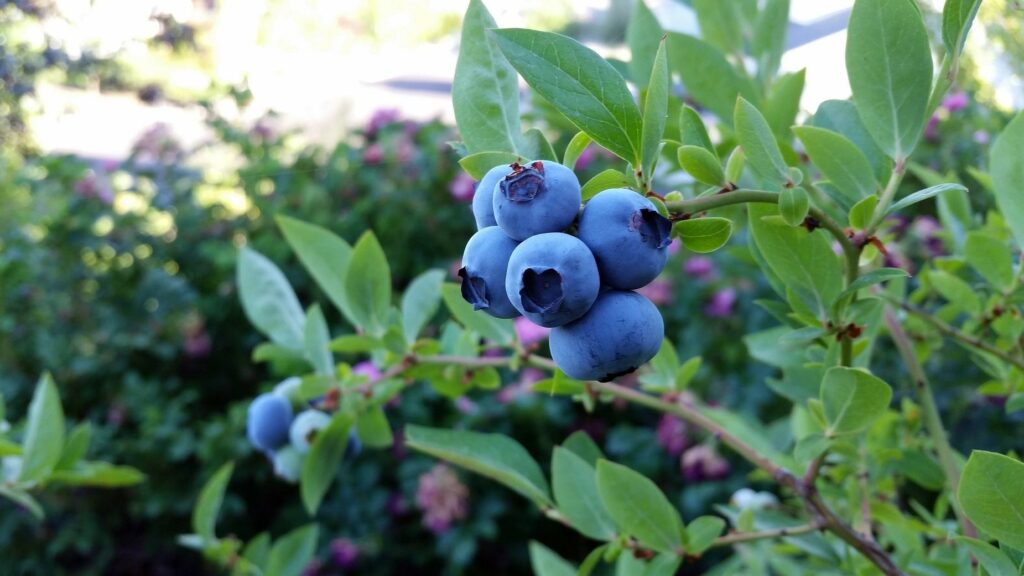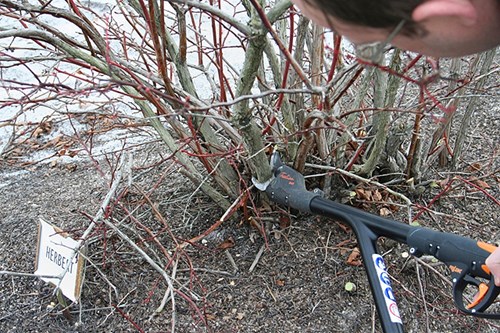
Blueberry bushes – next to plum trees or blackberries – are a favorite of home gardeners and fruit enthusiasts alike. What’s better than being rewarded with fresh, homegrown berries for your gardening work?
However, pruning is essential to ensure your plant reaches its full potential and yields a rich harvest of plump and flavorful blueberries. Not only is pruning crucial to maximize fruit production. It also plays a role in the overall health of blueberry bushes.
In this article, we’ll cover everything you need to know about how to prune blueberries and help you understand the importance of proper pruning techniques and timing. This step-by-step guide will provide you with all the necessary knowledge to make your blueberry bushes thrive. Read on, and you’ll have a delicious harvest of blueberries in no time!
About blueberry plants and their pruning basics
Blueberry plants are known for their delicate white or pink flower buds that give way to blueberries. While different varieties, such as lowbush, highbush, and rabbiteye, all have slightly different preferences, they all thrive in a climate featuring moderate summers and cool winters. Blueberry bushes love acidic soil.
But what is pruning, and why does it play a crucial role in maximizing the health and productivity of a blueberry bush? Pruning involves the selective removal of plant parts such as branches and helps prevent disease spread, promotes air circulation, and stimulates new growth. Annually trimming your blueberry bushes is essential for a good harvest.
Another blueberry pruning basis to know is the proper timing. The ideal time for pruning is during the dormant phase of the plant in late winter or early spring.
Pruning Techniques for Blueberries
There are several methods you could use to prune your blueberry bush.
- Selective pruning – Selective pruning involves removing specific branches and canes of the bush. This pruning technique is used to get rid of dead and damaged branches to help improve the overall structure and health of the plant.
- Thinning – Thinning helps in overgrown areas of the bush. Thinning out those areas enhances the airflow, promoting better fruit production.
- Rejuvenation pruning – This method is commonly used for mature blueberry plants. It involves removing old canes at the base of the plant. That gives a chance for new shoots to grow.
- Tip pruning – Tip pruning is beneficial for young blueberry bushes as it promotes their development. Remove the tips of the branches or the terminal buds to encourage lateral growth.
Tools and equipment – what do you need?
Some good news for you – the essential equipment for pruning blueberry bushes is simple and doesn’t break the bank! So, what do you need to get started?
- Pruning shears – Whether you’re pruning a blueberry bush or a Fiddle Leaf Fig, you need a pair of good quality pruning shears. Hand pruners are for cutting smaller branches and figs.
- Loppers – Loppers are used just as pruning shears are. However, they are stronger and have more cutting power. Pruning shears can’t cut through thicker branches – that is when you’ll need a pair of loppers.
- Pruning saw (optional) – This gardening tool is not generally necessary for pruning blueberry bushes but may become handy for overgrown bushes.
- Gloves – Get a pair of sturdy gardening gloves to protect your hands from thorns and rough branches. Ensure they fit well – comfort is key!
Disinfectant spray – This is a game changer! Disinfect your pruning tools after each cut – this helps to prevent the spread of diseases and pathogens.
Always ensure that you’re using clean and sharp tools. Having the right equipment in hand makes blueberry pruning incredibly easy and comfortable.
How to prune blueberry bushes step-by-step

So, now you know the importance of annually pruning blueberry bushes, understand the proper techniques, and have all your essential tools. It’s time to go over a simple step-by-step guide to pruning blueberries. Always ensure you are working with a healthy plant and clean tools.
- Identify any dead, diseased, or otherwise damaged branches. Remove them.
- Remove weak and crossing branches.
- Shape the bush. Selectively choose branches to remove to get the look you’re aiming for.
- Thin out any overgrown areas to promote air circulation.
- Remove old canes when working with older plants.
- Stimulate lateral growth by tip pruning. Recommended for younger plants.
Once you are finished, ensure you dispose of the pruned materials properly to prevent any spread of pests or diseases. Give your plant a deep watering to nourish it and don’t forget to add a layer of mulch around the base of the plant. That helps to regulate the soil temperature and conserve moisture.
Aftercare and maintenance
Want to keep your freshly pruned blueberry bush healthy, encourage new growth, and avoid diseases? It is vital to follow proper post-pruning maintenance practices.
Blueberry plants benefit from regular fertilization – aim for at least once, if not twice a year. There is no set time for fertilizing blueberry plants, but many gardeners recommend doing it in spring before new growth emerges.
Maintain consistent moisture levels through deep, regular watering and mulching to retain soil moisture. Keep the soil evenly moist but don’t go overboard.
Regularly monitor the plants for any signs of diseases or pests. To prevent diseases and pests, promote air circulation through pruning, remove diseased branches, and use appropriate fungicides when necessary.
Common mistakes to avoid when trimming blueberry bushes
Perfecting your gardening skills comes through trial and error. However, there are some common mistakes to avoid making when pruning blueberries. The most common mistakes are over-pruning, making incorrect cuts, and pruning at the wrong times.
To avoid over-pruning, focus on removing dead or damaged branches and thinning out overgrown areas. You can always go back and prune more of the bush at the end for a desired shape, but you can’t undo excessive pruning. Made an incorrect or messy cut? Trim the damaged area. And remember to prune your plant during the dormant phase, as the plant is less sensitive during that time!
Understanding the correct pruning technique and being aware of possible pitfalls is a good start to maintaining a healthy blueberry bush.
To sum it up
Everyone with a blueberry bush should understand blueberry plants and their pruning basics to maximize their health and productivity. With proper pruning techniques discussed in this article, your blueberry plants will flourish and, in return, give you harvests of delicious, plump blueberries year after year.
Frequently Asked Questions
Blueberry bushes should be pruned during their dominant phase in late winter or early spring before the new growth period begins. The pruning process is pretty simple and involves removing any dead and damaged branches and thinning out crowded areas of the bush.
Do you need to prune blueberry bushes?
Pruning your blueberry bush is necessary to maintain a good production of fruit. Pruning has many benefits, such as promoting healthy growth, increasing air circulation, reducing disease risk, and enhancing fruit production. Not pruning blueberry plants results in overgrown bushes and poor fruit production.
Can pruning hurt my blueberry bush?
Pruning can hurt your blueberry bush only when done incorrectly – don’t prune the plant during its growth period, and avoid over-pruning. Using correct pruning techniques and doing it at the right time does not harm blueberry bushes.
How often to prune blueberry bushes?
Blueberry bushes require annual pruning to maintain their health and productivity. The extent of pruning varies depending on the age and condition of the bushes – young plants generally require lighter pruning, and older and more established bushes may benefit from more extensive pruning.

